|
In this Issue...
- Letter from the President
- IBNS 2019: Double Award Winners Spotlight
- Social Media in Research: Workshop at IBNS 2019
- Keep Calm and Science On
- IBNS 2020 Conference - The Pipes Are Calling
Letter from the President
Hello IBNSers,
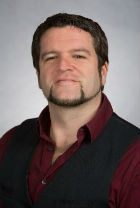 Let us face facts, IBNS 2019 was truly an exceptional meeting for the Society - Fantastic science, a great location, and wonderful events (puppies at break, brilliant!). We had 3 concurrent symposia and still could not fit in all that had been submitted to us. Thanks to all that really drove the meeting, from Dr. Scott Hall (President), Drs. Farida Sohrabji and Elizabeth Byrnes (Chairing the Program Committee), Drs. Corina Bondi and Sarah Baracz (Chairing the Education & Training Committee), Dr. Patricia Barra De La Tremblaye (Student Council Representative), to everyone on the Local Organizing Committee (Chaired by Dr. Stephen Kent), and of course Mrs. Marianne Van Wagner (Executive Director). In addition, so many provided fantastic support, too many to list, but thank you all for making #IBNS2019 the largest meeting we have ever held. Let us face facts, IBNS 2019 was truly an exceptional meeting for the Society - Fantastic science, a great location, and wonderful events (puppies at break, brilliant!). We had 3 concurrent symposia and still could not fit in all that had been submitted to us. Thanks to all that really drove the meeting, from Dr. Scott Hall (President), Drs. Farida Sohrabji and Elizabeth Byrnes (Chairing the Program Committee), Drs. Corina Bondi and Sarah Baracz (Chairing the Education & Training Committee), Dr. Patricia Barra De La Tremblaye (Student Council Representative), to everyone on the Local Organizing Committee (Chaired by Dr. Stephen Kent), and of course Mrs. Marianne Van Wagner (Executive Director). In addition, so many provided fantastic support, too many to list, but thank you all for making #IBNS2019 the largest meeting we have ever held.
Many congratulations to Dr. Robert Gerlai for winning the Outstanding Achievement Award, and Dr. Zackary Cope for winning the Early Career Award. Both thoroughly deserved for their research and strong support of IBNS and its mission over the years!
This year’s meeting also saw the creation of our Ethics & Diversity committee with Drs. Amanda Kentner & Debra Bangasser Chairing. This committee was tasked with creating the code of conduct that we should all adhere to while at the meeting, in addition to focusing on efforts to enhance diversity within the Society. To that end, Drs. Kentner and Bangasser are supported by Drs. Tiffany Donaldson, Susan Sangha, Stephen Kent, Millie Rincón-Cortés, Gregory Carr, and myself. We are delighted that we now have detailed mechanisms to support people at the meeting, while also encouraging diversity within the Society. We benefited this year by being able to invite two members from under-represented countries thanks to sponsorship from Thorlabs. In addition, thanks to the generosity of our keynote speaker Dr. Gavan McNally, we were also able to invite additional travel awardees! If you want to know more about the committee and our efforts, please do not hesitate to reach out to any one of us (see website for details). This year was also the first of our mentor/mentee rollouts, to enhance the mentees’ experience even beyond the Meet the Professionals luncheons we hold each year (thanks to Plexon-Lafayette for their sponsorship). Many thanks to all the mentors and Professionals for their continued support of the future of behavioral neuroscientific research! Stay tuned for the outcome of this meeting, namely reviews from the keynotes and symposia that will be compiled into a special issue from Neuroscience Biobehavioral Reviews!
Of course, being the new President, I want also to tell you of our future. I am delighted for the opportunity to be in this position, ushering in our next meeting in Glasgow, Scotland, in June 2020! Given that I am Scottish born and raised, it is wonderful to be able to go back to Scotland with you all, this Society that has felt like family over the years. If you have never been to Scotland, jump at the chance – it is a beautiful, friendly country, go see the Highlands, probably the most beautiful part of the world that I have ever seen. With Edinburgh only a 45 min train ride from the location, you will get to see and experience many of the best parts of Scotland while basking in the excellence in science. Get your colleagues together and submit your symposia, travel award applications, and simply posters to come to this magical country.
Incidentally, I have received questions on whether it may be felt to be cultural appropriation were any non-Scots to rent a kilt at any point (e.g., the banquet…). First of all, we Scots are happy to share our culture with the world. A kilt is one of the most comfortable things to wear; I strongly encourage anyone and everyone to try one (males, females, and all in-between) – when else will you get the chance? That point convinced many friends and family members at my partner and my wedding in 2014 (see picture), wherein numerous Americans, Mexicans, French, German, and others all took advantage of the opportunity. So, come to Scotland for the science, stay for the amazing whiskies and opportunities for fun!
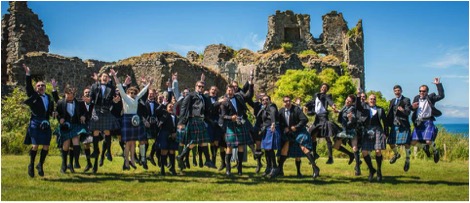
Stay tuned for hints and tips for things to see and do while in Scotland. Looking forward to seeing you there, so get those symposia proposals in by October 1st 2019!
Yours,

Jared W. Young
IBNS President
Department of Psychiatry
University of California, San Diego
Back to Top
IBNS 2019: Double Award Winners Spotlight
By Valerie Bolivar, Ph.D., Guest Editor
Mouse Behavioral Phenotype Analysis Core
Wadsworth Center, New York State Dept of Health
At this year’s meeting, two young scientists were the recipients of both Travel Awards and Best Poster Awards – Mariela Faykoo-Martinez at the Graduate Student level and Leigh Walker at the Postdoctoral level. I asked these awardees for their impressions of the IBNS 2019 meeting. Mariela shared a First Impressions reflection as this was her first IBNS conference to attend. And, Leigh shared Second Impressions as she previously attended the 2017 meeting in Hiroshima, Japan.
IBNS Conference: First Impressions
By Mariela Faykoo-Martinez
University of Toronto, Mississauga, ON, Canada.
Graduate Student Travel Awardee
2019 Graduate Student Best Poster Awardee
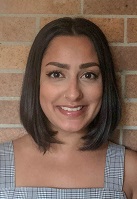 As a 3rd year PhD student in the conference circuit for ~5 years, I had always heard about this international society focusing on behavioral neuroscience [that chose only the best of locations]. I finally felt ready to bring my thesis work to the international stage and put a lot of care into putting together my travel award application. I was elated when I received the email that I had been selected for the travel award that granted me passage to Cairns, as well as the opportunity to give oral and poster presentations. My thesis work uses the naked mole-rat to study how social environment can alter pubertal timing; naked mole-rats live in colonies and will never enter puberty if they remain in the presence of a dominant queen. I use genomic approaches to understand the coordinated activity of brain regions at a molecular level in naked mole-rats released from pubertal suppression, with the hope of elucidating the mechanism. I thought this conference would be an amazing opportunity to branch out, learn about what research is driving the field forward and perhaps, find a niche for myself. As a 3rd year PhD student in the conference circuit for ~5 years, I had always heard about this international society focusing on behavioral neuroscience [that chose only the best of locations]. I finally felt ready to bring my thesis work to the international stage and put a lot of care into putting together my travel award application. I was elated when I received the email that I had been selected for the travel award that granted me passage to Cairns, as well as the opportunity to give oral and poster presentations. My thesis work uses the naked mole-rat to study how social environment can alter pubertal timing; naked mole-rats live in colonies and will never enter puberty if they remain in the presence of a dominant queen. I use genomic approaches to understand the coordinated activity of brain regions at a molecular level in naked mole-rats released from pubertal suppression, with the hope of elucidating the mechanism. I thought this conference would be an amazing opportunity to branch out, learn about what research is driving the field forward and perhaps, find a niche for myself.
Arriving in Australia this past June, I was in disbelief a conference would take place in such a tranquil and idyllic location. I was even more pleased to find the welcoming environment that the returning society members created for first-timers such as myself. The first night set the tone for the rest of the conference – a friendly, inviting atmosphere for delving into some ground-breaking science with the great minds of the field. Each day was filled with a broad range of science, with symposia switching between the latest in neuropsychiatric research to parasitoid wasps that become zombified from a toxin injected into their brain. There was a topic for everyone to engage with and invaluable networking (both during and after hours).
A highlight for me in particular was the new mentorship program that IBNS arranged this year. As part of a pilot program, travel awardees were given the opportunity to select a mentor (volunteers from the IBNS community) to meet during the conference. I had the pleasure of meeting former IBNS President Dr. Kelly Lambert, who had arranged a symposium on neuroethology and recently has begun working on raccoons. It was a great opportunity to connect with another researcher who deals with the challenges of working with relatively untouched model species. A second highlight was a true surprise and honour to me – I was selected as winner for best poster. Coming into this conference, I was unsure how my work would be accepted given that it dives heavily into computational biology side, and, focuses on a species most people know little about. After a wonderful experience engaging with the society’s lovely members, winning two awards and receiving so much fantastic feedback on my work, I feel I too am now a member of the IBNS community.
Thank you IBNS for the outstanding conference and I cannot wait to hear the bagpipes in Glasgow, Scotland!
IBNS Conference: Second Impressions
By Leigh Walker, Ph.D.
Florey Institute of Neuroscience and Mental Health, Melbourne, Australia
Postdoctoral Travel Awardee
2019 Postdoctoral Best Poster Awardee
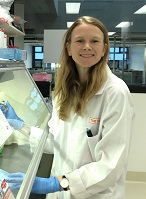 IBNS has fast become my favourite conference. I attended my first IBNS meeting in Hiroshima, Japan, 2017 as a PhD student, and the warm, supportive environment left a lasting impression on me. So, when the news came that IBNS was coming down under to Australia in 2019 I was thrilled! While I am originally from New Zealand, I completed my PhD and am currently working as a postdoctoral researcher at the Florey Institute of Neuroscience and Mental Health, in Melbourne, Australia. My research focuses on understanding the neurobiology underlying addiction, so glancing at the line-up of speakers for the 28Th annual IBNS Meeting I knew it was going to be a busy week. IBNS has fast become my favourite conference. I attended my first IBNS meeting in Hiroshima, Japan, 2017 as a PhD student, and the warm, supportive environment left a lasting impression on me. So, when the news came that IBNS was coming down under to Australia in 2019 I was thrilled! While I am originally from New Zealand, I completed my PhD and am currently working as a postdoctoral researcher at the Florey Institute of Neuroscience and Mental Health, in Melbourne, Australia. My research focuses on understanding the neurobiology underlying addiction, so glancing at the line-up of speakers for the 28Th annual IBNS Meeting I knew it was going to be a busy week.
From the perspective of a junior scientist, the support and mentorship offered by IBNS is unparalleled. I have been fortunate enough to receive generous financial support from IBNS over the years, receiving a Travel Award as both a graduate student and now as a postdoctoral researcher. In 2017, my award helped me travel all the way to Japan, a trip that as a PhD student wouldn’t otherwise have been feasible. This year, my award helped me travel to Cairns, a truly beautiful part of Australia I had never explored before. Aside from the financial support, the Travel Award also gave me the opportunity to present in the data blitz session (which is a feat in itself to condense everything into a semi-coherent 3 min talk) and to take part in the poster competition. During the poster session, I had the chance to discuss my recent findings with a number of behavioural neuroscientists from around the world. Adding to my series of fortunate events with IBNS, I was awarded “best postdoctoral poster” at the banquet dinner. The waved membership fee I was awarded will help me to continue attending future IBNS meetings.
IBNS 2019 also saw the beginning of a new mentoring programme, which in my experience was a great success. It gave me the opportunity to gain valuable career advice from a senior researcher, in a relaxed setting, over a beer. I look forward to seeing this expand and flourish over the next few years.
All of this would not be possible if it weren’t for the wonderful people involved in the IBNS community. IBNS provides opportunities to network that are unmatched by any other meetings I have attended. The size and structure of the meeting gives young researchers, like me, the time needed to engage with scientists from around the globe and establish meaningful connections and collaborations. An example of one of the truly amazing people involved in the IBNS community is Professor Gavan McNally, who aside from giving an exceptional plenary lecture, gave up his speaker allowance to support Travel Awards so more ECRs had an opportunity to experience IBNS 2019.
I would like to sincerely thank IBNS and everyone who made this conference so enjoyable and genuinely supportive. I look forward to seeing everyone at the 29th Annual Meeting in Glasgow, Scotland.
Back to Top
May Newsletter vol 23-6 Guest Editor:
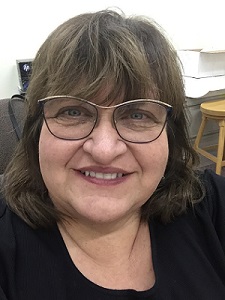
Valerie Bolivar, Ph.D.
Director, Mouse Behavioral Phenotype Analysis Core
Wadsworth Center, New York State Dept of Health
Thank you for volunteering your time
as Guest Editor, Valerie!
Interested in serving as a Guest Editor for the IBNS News?
Email: [email protected]
Looking for a New Employment Opportunity or Struggling to Find the Right Candidate? Meet the IBNS Career Center!
One of the biggest challenges for any international scientific society is to provide quality and informative support to its members, whether it's for a new employment opportunity or finding the right candidate for a newly opened position. The IBNS online Career Center portal (http://jobs.ibnsconnect.org) provides the right tools for both job seekers and employers.

The IBNS Career Center portal offers all the standard operational features; such as a thorough search engine by keyword and location, as well as a free review of your resume for feedback, and a job-posting service for employers. However, what makes the IBNS Career Center stand out in terms of support is two additional quality features: resources for job seekers & access to a resume bank for employers.
 In the Resources section, you have access to a number of articles with valuable tips in building a resume, job seeking, and communication. These tips come from experienced scientists in the field -- not only for searching or applying for a position, but also for the interview process. Interested in 'building your brand’ or strengthening your social media presence? You will find plenty of advice and tips to do so, which will help strengthen your image and move your career to the direction you want! In the Resources section, you have access to a number of articles with valuable tips in building a resume, job seeking, and communication. These tips come from experienced scientists in the field -- not only for searching or applying for a position, but also for the interview process. Interested in 'building your brand’ or strengthening your social media presence? You will find plenty of advice and tips to do so, which will help strengthen your image and move your career to the direction you want!
In the Resume Bank, potential employers have free access to a large bank of resumes and profiles. You can customize the filters that apply to your search and create lists of candidates that fulfill your own criteria.
Back to Top
Social Media in Research: Workshop at IBNS 2019
By Liisa Galea, PhD
Department of Psychology
Djavad Mowafaghian Centre for Brain Health, University of British Columbia
On June 27, 2019 in beautiful Cairns, Australia, we held a workshop on Social Media in Science. Rachael Engels from Elsevier spoke about leveraging the publishing experience to promote your research by using available tools on social media. For example, Elsevier uses Sharelink, which the corresponding author will receive as a link to share on social media with free access to your published paper allowing you to promote your article for free for 50 days even if your publication is not “gold” open access. Next, Liisa Galea talked about the threat of predatory publishers presenting work from Shen and Bjork (2015) showing the increase in articles published in predatory journals from 53,000 articles in 2010 up to 420,000 articles published in 2014. Another study showed that 16% and 25% of predatory journals retrieved in neuroscience and neurology, respectively, are indexed in PubMed (Manca et al 2017). Making it mandatory that we inform ourselves and students that journal home does matter. As of 2017, predatory journals outnumber legitimate journals in neurology (101 versus 73; Manca et al., 2017). The topic of the rise of fake science is outlined effectively in a recent news article. Although some scientists may be reluctant to embrace social media as a form to promote and discover research, we showed some new data to support the ascertain that scientists that use social media have more downloads of their papers (Widmer et al, 2019). Furthermore, data suggests that once scientists reach over 1000 followers on Twitter that their messages are reaching beyond the scientific community to public and media members (Cote and Darling, 2018), an important milestone for knowledge dissemination. Formal presentations ended with some Do’s and Don’ts of Twitter. Then we had our expert panelists that all use social media effectively and from different perspectives: Kate Wassum, Daphne Ling, Debra Bangassar, Jared Young and Scott Hall (Facebook). Each of our panelists use Twitter (or for Scott Hall Facebook) to promote scientific discovery in behavioural neuroscience. Daphne gave us a perspective from a trainee on the use of social media. The format was short talks followed by Q&A.
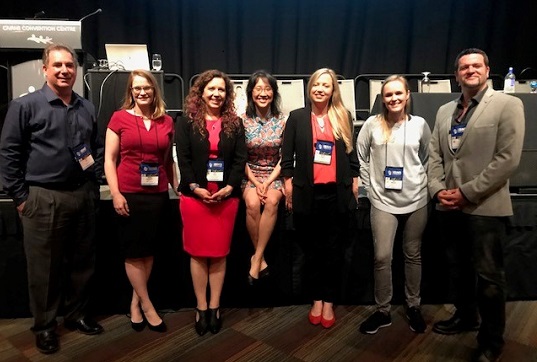
The consensus, following the Q&A, not surprisingly, was that social media, when used wisely, was a great platform for promotion of science. Finally, if you weren’t able to get to Cairns for IBNS this year, check out #IBNS2019 to see what you missed...another wildly effective use of social media in research!
Back to Top
Keep Calm and Science On
Julianne Jett, PhD
Department of Pharmacology
University of Texas Health Science Center San Antonio
Academic research is a demanding and often stressful profession between the need to publish or perish, apply for grants, problem solve experiments, juggle mentoring and teaching… I could go on, but my blood pressure is rising just thinking of our daily to-dos. Even when we attend conferences in amazing locations, like Cairns, Australia, there is at the very least networking to be done, science to discuss, and on-going experiments to manage from afar. However, thanks to the efforts of our Executive Director Marianne Van Wagner, the IBNS 2019 Conference drummed to a slightly different beat. Courtesy of The Dome, IBNS raffled off two tickets to the local wildlife zoo, as well as tickets generously donated by the Cairns Aquarium. Determined to get us out of the conference for some fun, IBNS also provided two tours to the Great Barrier Reef – truly a once in a lifetime experience.
And for those of us that couldn’t go sightseeing, Marianne was sure to bring some fun and relaxation to the conference. In addition to having members join cultural dances at the opening reception, free massages were given to the first 20 attendees that registered for the meeting (courtesy of the Pullman International Hotel). And to compliment coffee during the breaks, IBNS had The Dome bring reptiles to the conference for our members to enjoy. But let’s face it, being visited by puppies from the local Yaps Shelter easily stole the show. Clearly, our President Jared Young was a big fan!
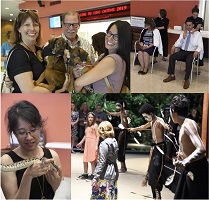 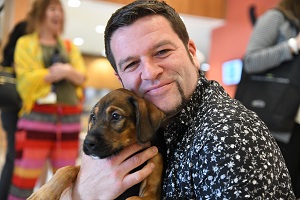
I ask you, what other conference offers opportunities to get your adrenaline pumping and your oxytocin flowing while simultaneously presenting outstanding neuroscience research? I am lost to think of any. To Marianne, thank you for making IBNS 2019 unforgettable. You’ve set the bar high for the 29th Annual IBNS Conference in Glasgow, Scotland. I, for one, can’t wait to see what you cook up!
IBNS 2020 Conference - The Pipes Are Calling
Don’t miss out on the chance to attend IBNS’ next adventure! The 29th Annual IBNS Conference will be held at Caledonian University in Glasgow, Scotland, from June 2-6, 2020.
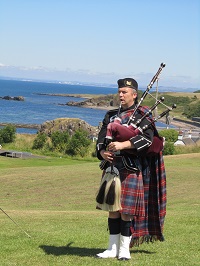 Conference deadlines have been set (see below), with symposia proposals due on Oct 1st. You can submit your proposal by visiting the IBNS website, and the IBNS central office is happy to assist you should you have any questions regarding the application process ([email protected]). Conference deadlines have been set (see below), with symposia proposals due on Oct 1st. You can submit your proposal by visiting the IBNS website, and the IBNS central office is happy to assist you should you have any questions regarding the application process ([email protected]).
In addition to submitting your proposals, we ask that you help us make #IBNS2020 the best conference to date by sharing our call for symposium proposals and upcoming deadlines with your colleagues. You can easily share this information by downloading our flyer here.
IBNS 2020 Conference Deadlines:
October 1, 2019: Symposia Proposals Due
December 6, 2019: Travel Award Applications Due
February 3, 2020: Abstract Submissions Due
June 2-6, 2020: Conference Dates
Back to Top
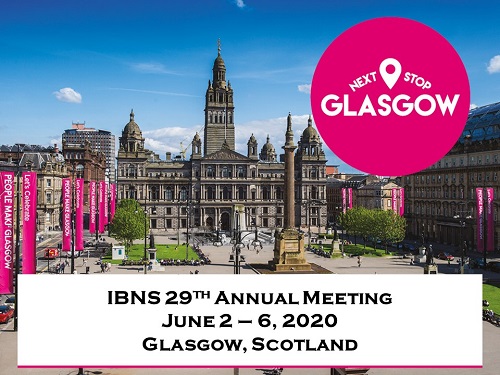
|